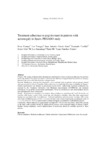Treatment adherence to pegvisomant in patients with acromegaly in Spain: PEGASO study

View/
Use this link to cite
http://hdl.handle.net/2183/22380Collections
- Investigación (FCS) [1293]
Metadata
Show full item recordTitle
Treatment adherence to pegvisomant in patients with acromegaly in Spain: PEGASO studyAuthor(s)
Date
2019-02-13Citation
Cámara R, Venegas E, García-Arnés JA, Cordido F, Aller J, Samaniego ML, Mir N, Sánchez-Cenizo L. Treatment adherence to pegvisomant in patients with acromegaly in Spain: PEGASO study. Pituitary. 2019 Apr;22(2):137-145.
Abstract
[Abstract] PURPOSE: The burden of chronic daily subcutaneous administration of pegvisomant on adherence has not been previously studied. This study was aimed to determine the adherence to pegvisomant treatment in acromegaly patients in the real-world clinical practice setting in Spain.
METHODS: Multicenter, observational, descriptive, cross-sectional study in patients with acromegaly treated with pegvisomant for at least 12 months. Patient adherence was indirectly determined by Batalla and Haynes-Sackett questionnaires and directly by prescription record review. Additionally, treatment satisfaction was assessed by the Treatment Satisfaction with Medicines Questionnaire (SATMED-Q) and treatment convenience by an ad-hoc Pegvisomant questionnaire. Errors in reconstitution and administration process were determined by direct observation.
RESULTS: 108 patients were included in the analysis. Rates of adherence varied from 60.7 to 92.1% and did not correlate with disease control. Older patient age and alternative schedules other than daily pegvisomant dosing were associated with lower adherence. Treatment satisfaction and convenience was high, with a mean (SD) total SATMED-Q score of 74.6 ± 15.4 over 100 and a total ad-hoc Pegvisomant questionnaire score of 71.2 ± 15.2 over 100. 34.3% of patients made mistakes during the reconstitution /administration process.
CONCLUSIONS: Patient adherence to pegvisomant was high (60.7-92.1%), but more than a third of the patients in the study made mistakes during the administration process, with a potential impact on disease control. Besides dosing compliance, correct administration of medication should be carefully assessed in these patients.
Keywords
Patient compliance
Medical adherence
Patient satisfaction
Pegvisomant
Medication errors
Acromegaly
Medical adherence
Patient satisfaction
Pegvisomant
Medication errors
Acromegaly
Description
The final publication is avaliable at Springer Link
Editor version
ISSN
1386-341X





